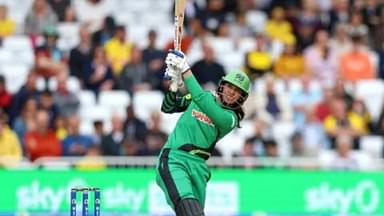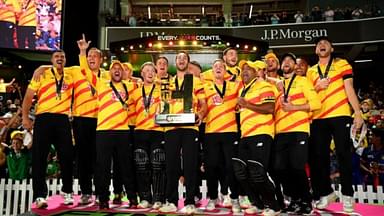The Hundred rules: The trailblazing 100-ball tournament is all in readiness to put on display something contrasting for cricket fans.
Advertisement
ECB (England Cricket Board) will set the ball rolling with respect to their latest innovation titled “The Hundred” from tomorrow. The month-long trailblazing tournament will be played between eight teams which will represent seven cities namely Manchester, Headingley, Birmingham, Nottingham, Cardiff, London and Southampton.
As is the case in other domestic tournaments in England, London will be represented by two teams due to the presence of two iconic stadiums in the Lord’s and The Oval.
ALSO READ: The Hundred 2021 Women’s squads of all teams
The Hundred, which ended up being delayed by a year due to the outbreak of COVID-19 pandemic last year, has been affected by the global crisis this year as well. The latest consequence of COVID-19 has resulted in the withdrawals of multiple top-notch players who chose to skip the tournament due to several reasons.
Super excited for the start of @thehundred 🏏
Catch @manchesteroriginals opening game tomorrow 18:30 (local time, 19:30 SA time).#ManchesterOriginals
#🖤🐝📸 @ggf_photos pic.twitter.com/vKweKE6gNv
— Mignon du Preez (@MdpMinx22) July 20, 2021
Having said that, the novelty of a 100-ball format has it in it to allure eyeballs of cricket fans from across the world. With an ICC T20 World Cup to be played later in the year, a shortened tournament like this is highly likely to unearth a few talented cricketers.
The Hundred rules
1) Toss – The toss does not have to take place on the ground.
2) 100 balls per innings – As mentioned above, each innings will comprise of 100 balls.
3) No ‘overs’ – The Hundred will do away with the age-old concept of “over” in cricket. As a result, 100 balls will be divided into blocks of five deliveries. At maximum, a bowler can bowl two consecutive blocks of five deliveries. After the end of five balls, umpires will show a white card and call “five” to signal the end of one block to players, scorers, broadcasters and spectators.
4) Change of ends after 10 balls – Until now, ends used to get changed after each over irrespective of the format in competitive cricket. However, The Hundred will allow players to play from the same end for 10 balls, i.e., two blocks of five deliveries.
5) Bowler delivers either five or 10 consecutive deliveries – Fielding captains will have the option of bowling the same bowler for either five or 10 deliveries. Having said that, the maximum a bowler can bowl in an innings is 20 balls which follows the current white-ball rule where a bowler bowls one-fifth of the total number of deliveries of an uninterrupted innings.
6) Powerplay – A 25-ball powerplay at the start of each innings.
7) Strategic timeout – Fielding sides will get one strategic timeout of two and a half minutes per innings. It can be opted anytime after the powerplay.
8) No crossing of batters – In case of a caught dismissal, batters won’t be allowed to change strike even if the two of them have crossed each other while running between the wickets. In simple words, a new batter will always take the strike after a caught dismissal provided the outgoing batter doesn’t get out on the last ball of a 10-ball block.
9) DRS – DRS (Decision Review System) will be used for the first time in any English domestic match.
10) Tied match – Each team will get a point each if a league match results in a tie. In case of a tied knockout match, teams will have to play a ‘Super Five’. A second ‘Super Five’ will be played if the first one also gets tied. If the second ‘Super Five’ also results in a tie, the team which finished higher in the Group stage will be declared as the winner.
11) Over rate – If a team is behind their over rate, they shall be required to field with one fewer player outside the circle from the point the penalty is incurred.
12) Duration – An average The Hundred match will last for two and a half hours.




